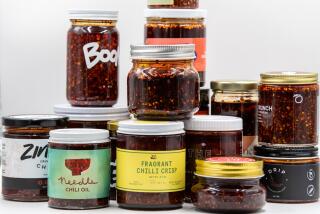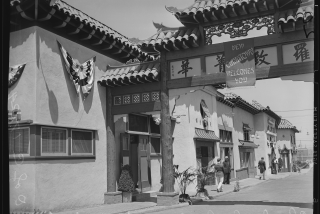U.S. Consultants Teaching China to Wrap : Trade: As that nation steps up exports to the United States, it hopes to improve its production and marketing--and be aware of cultural nuances.
Consider the “Void Pit Shortbread Biscuit.” Produced in mainland China, it is reputedly a tasty morsel, and the Chinese want to export large quantities to American supermarkets.
The Chinese, however, are unlikely to enjoy success in the United States until they develop a more appetizing name for the product. After all, the “biscuit” is just a cookie with a hole in the center.
This is one of many merchandising goofs discovered by an American delegation of marketing and package design experts on a recent tour of production and packaging plants in China. The delegation, dominated by Californians, also discovered an irony that U.S. trade experts are beginning to acknowledge: The Chinese have indeed begun to export more to the United States; but in many respects, their success--like the void pit biscuit--has a hole in the middle.
Export data seems to show that China is striding strongly into American markets. Chinese exports to the United States are expected to exceed $10 billion this year. That would represent a 300% increase in two years. The ratio of U.S. imports from China to its exports to China is greater than 3 to 1, higher than any other U.S. foreign trade imbalance.
However, much of China’s sales success in the United States can be traced to a massive shift from plants in export-oriented Hong Kong and Taiwan to southeastern China. Savvy industrialists in Taiwan and Hong Kong have become partners in joint ventures with the Chinese government, building production facilities in China to take advantage of low labor costs, said Mike Van Horn, a San Francisco-based trade consultant who specializes in Asian investment.
Once workers in China produce and package goods based on specifications set in Hong Kong and Taiwan, businesses in those two capitalist enclaves merchandise the goods in Western markets, said Michel Oksenberg of the University of Michigan’s Center for Chinese Studies.
To boost exports and obtain more control of export revenue, Beijing is looking for ways to improve production, packaging and marketing. As part of an effort to reduce reliance on Hong Kong and Taiwan, China’s International Center for Economic and Technical Exchanges enlisted the help of Kay Lau, head of Kay Lau & Associates, a Sherman Oaks-based marketing consultant.
Lau organized and led a delegation of 12 marketing and packaging experts on a tour of China’s production and packaging facilities in March and April. The group held seminars and arranged exhibitions of the best in Western merchandising and packaging. Delegation members have continued to correspond with Chinese engineers and plant managers, providing advice and critiques of Chinese packaging and marketing ideas, Lau said.
“The Chinese are very good at producing to specifications set by others,” Lau said. “The people at our lectures weren’t working with Taiwan and Hong Kong, and they want to export directly. They need advice and expertise.”
A marketing and packaging expert in the delegation, Robert McMath of the New Products Showcase & Learning Center in Canandaigua, N.Y., said: “It’s an ironic situation because environmentalists have been warning Western businesses about the environmental dangers posed by too much packaging and too much waste.
“The Chinese don’t need to over-package to get access to export markets,” McMath said, “but they have to do a better job of displaying and marketing their products.”
Lau urged makers of the Void Pit Shortbread Biscuit to develop a more commercially viable name. There were also engineering problems--boxes that did not properly envelop certain products.
Lau said she also observed many labeling problems. For example, one industrial association eager to export had abbreviated its name on the labels of its products. Unaware of nuances in the English language, they abbreviated “association” as “ass.” on their labels, she said.
Members of the Lau delegation also noted production-related labeling problems. The labels of some beer bottles were glued only at the edges, sometimes leaving a sag in the middle of the paper strip. Also, a printing press at one labeling plant only had the capacity to produce two colors per press run. If the manager wanted a four-color label, the paper strips had to be put through the press twice--sometimes obscuring or dulling the colors from the first press run.
In another case, Qu Xiang Big Jia, a Canton bakery known for quality goods, put labels for its products. But the type faces and colors of labels varied from product to product, she said, robbing the bakery of a clear identity. And the bakery’s name--a potentially alluring trademark--was sometimes obscured or missing from labels.
On the other hand, some Chinese packaging was creative and effective, Lau said. For example, the same Canton bakery places cakes in a package similar to a hat box. A handle on the top of the box allows consumers to handle the package without crushing the cake.
“If the Chinese are going to be major players in the export market, their packaging needs to be upgraded and made comparable to what the U.S. consumer is used to seeing, because a product’s outward appearance is a factor in its appeal,” Lau said.
More to Read
Inside the business of entertainment
The Wide Shot brings you news, analysis and insights on everything from streaming wars to production — and what it all means for the future.
You may occasionally receive promotional content from the Los Angeles Times.










